There hasn’t been an exhibition in the US along the lines of By Her Hand: Artemisia Gentileschi and Women Artists in Italy, 1500–1800 since 2007, when the National Museum of Women in the Arts (NMWA) hosted Italian Women Artists from Renaissance to Baroque. By Her Hand—currently on at the Wadsworth Atheneum Museum of Art in Hartford; traveling next February to the Detroit Institute of Arts—is well worth the wait.

In the 14 years since the NMWA exhibition, the landscape has changed dramatically. New works by early modern women artists have been discovered, and there are new discoveries about known works. By Her Hand is the site of a plethora of “firsts”—in terms of not only of US debuts of paintings, but also of access to privately owned works, and of the opportunity to view certain works in tandem.
The Installation
The Wadsworth exhibition showcases 17 early modern Italian artists, from Sofonisba Anguissola and Lavinia Fontana in the Renaissance, to Anna Bacherini Piattoli and Veronica Stern Telli toward the end of the eighteenth century. The 60 or so works are displayed in a single—albeit quite large—room. An advantage of this format is that if there is a cluster of people in any one part of the space, one can easily look at objects in a less congested portion of the room.

Another advantage of the layout is that it facilitates movement in any direction—forward, backward, or lateral. And this is an important feature, because the nature of the installation encourages a crisscross viewing pattern. The works are displayed thematically, rather than by artist or medium. A benefit of this organizational method is that some of the featured artists appear in more than one thematic grouping. At a certain point in the viewing experience, seeing an artist’s name once again is like running into an old friend.

Some of the artists—Artemisia Gentileschi, Sofonisba Anguissola, Elisabetta Sirani, and Rosalba Carriera among them—are represented in the exhibit with multiple works. For others—including Marianne Carlevarijs, Veronica Stern Telli, and Anna Piattoli—there is only a single work on display. Thus, another advantage of the thematic grouping is that while some makers are interwoven throughout the exhibition like a thread through a tapestry, no one individual dominates the show (though Artemisia, understandably and forgivably, comes close).

Juxtapositions
By Her Hand is an exercise in juxtapositions. The layout facilitates the side-by-side placement of works by artists from different centuries and backgrounds. Much of the art in the exhibition takes the form of oil-on-canvas paintings, but these are juxtaposed with other objects and/or forms of art (see below).
In a very few instances, works are by his hand, rather than hers, though they are included in the interests of celebrating women artists. So, there is also the occasional juxtaposition of works by men with works by women.
Some of the loans are from public collections, including college/university museums. Interestingly, these are juxtaposed with what seemed to me a surprisingly high number of works loaned by private collectors.

And finally, there is the juxtaposition of sizes—this must have presented such a challenge to the organizers! Some of the paintings, notably Artemisia Gentileschi’s David and Bathsheba and Lot and his Daughters (included in the picture above, at left; and see larger image below), are just enormous. Others, such as Woman with a Dog by Rosalba Carriera, could be held in the palm of a (small) hand.
Juxtaposing artists
Some of the featured artists lived at more or less the same time in history, and may even have known one another (for example, Artemisia Gentileschi and Giovanna Garzoni). But many of them lived decades, or even centuries, apart. In By Her Hand, the curators take the opportunity to place contiguously works by artists as far apart in time as Lavinia Fontana (1552–1614) and Rosalba Carriera (1673–1757). The juxtaposition of portrait miniatures by Fontana and Carriera highlights the role this art form played in launching the career of both artists.
I will note just a couple of other themes in the show that allow for fruitful, if perhaps unexpected, contrasts:

- Mary Magdalene. In about the middle of the right-hand wall are three very different depictions of the Magdalene. This central painting in this grouping, in its US debut, is Artemisia Gentileschi’s life-size, sensual Mary Magdalene in Ecstasy. To the left of this work is Simon Vouet’s half-length Virginia da Vezzo, the Artist’s Wife, as the Magdalene, in which the saint holds an oil jar, one of her traditional attributes. To the right of the Gentileschi interpretation is a three-quarter length Mary Magdalene—richly dressed and surrounded by flowers and worldly goods at the moment of her conversion—by the seventeenth-century artist-nun Orsola Maddalena Caccia.
The Gentileschi and Caccia Magdalenes are from private collections; thus, By Her Hand offers a rare opportunity to see either work even in isolation, never mind together, and together with the Vouet painting.

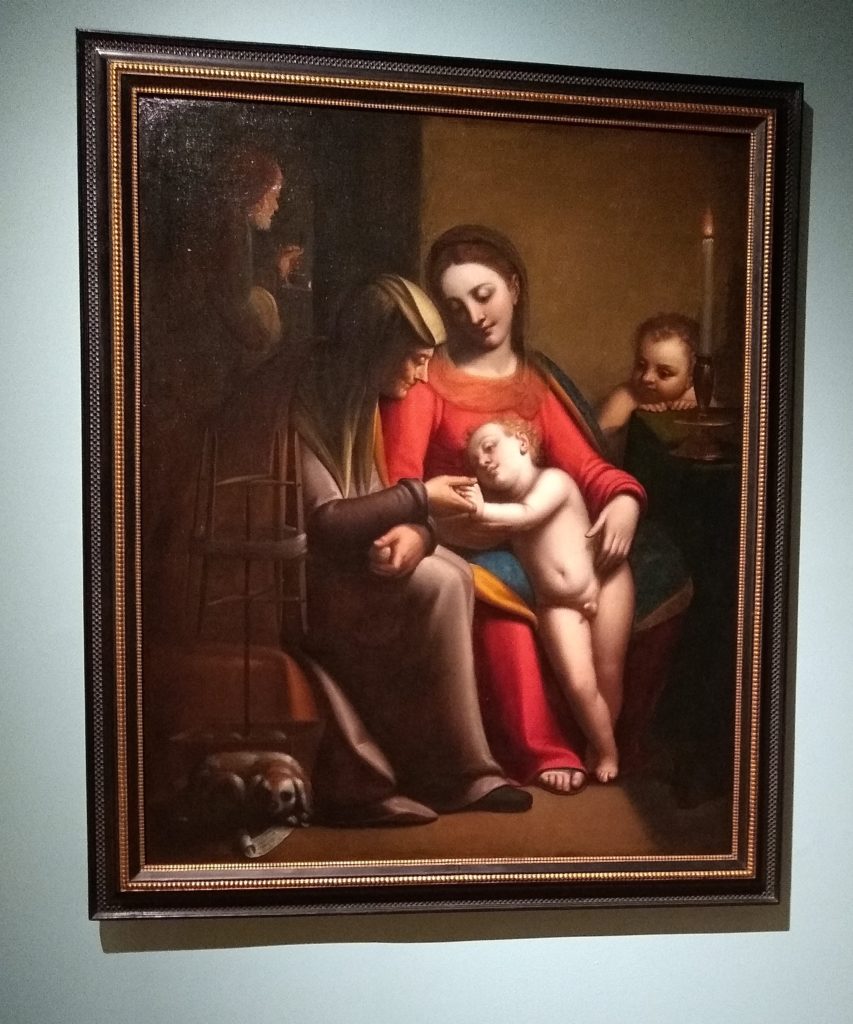
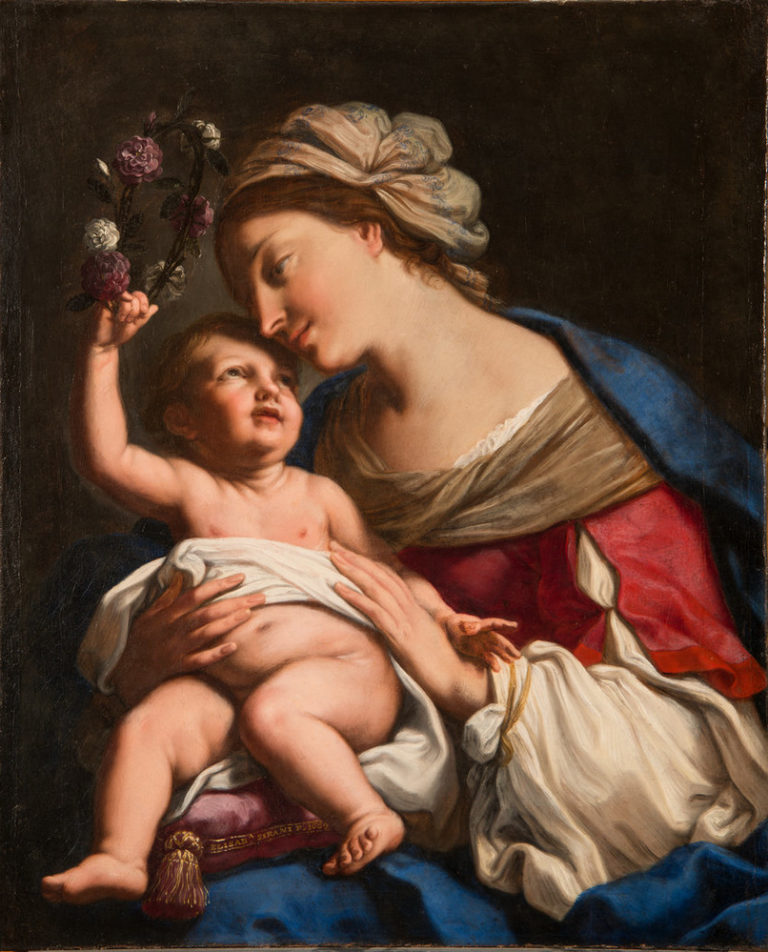
- Virgin and Child and/or Holy Family. Presented in the back right corner of the exhibition space are three large-scale paintings that depict some or all members of the Holy Family, with or without saints in attendance: Sofonisba Anguissola’s Holy Family with Saints Anne and John the Baptist; Elisabetta Sirani’s Madonna and Child; and Lavinia Fontana’s The Holy Family with Saint Catherine of Alexandria.
Juxtaposing mediums
The objects on view include not only paintings on canvas, but also paintings on ivory; paintings on copper; paintings on panel; drawings; gouache, watercolor, and/or tempera on paper; prints and etchings; books; and medals.
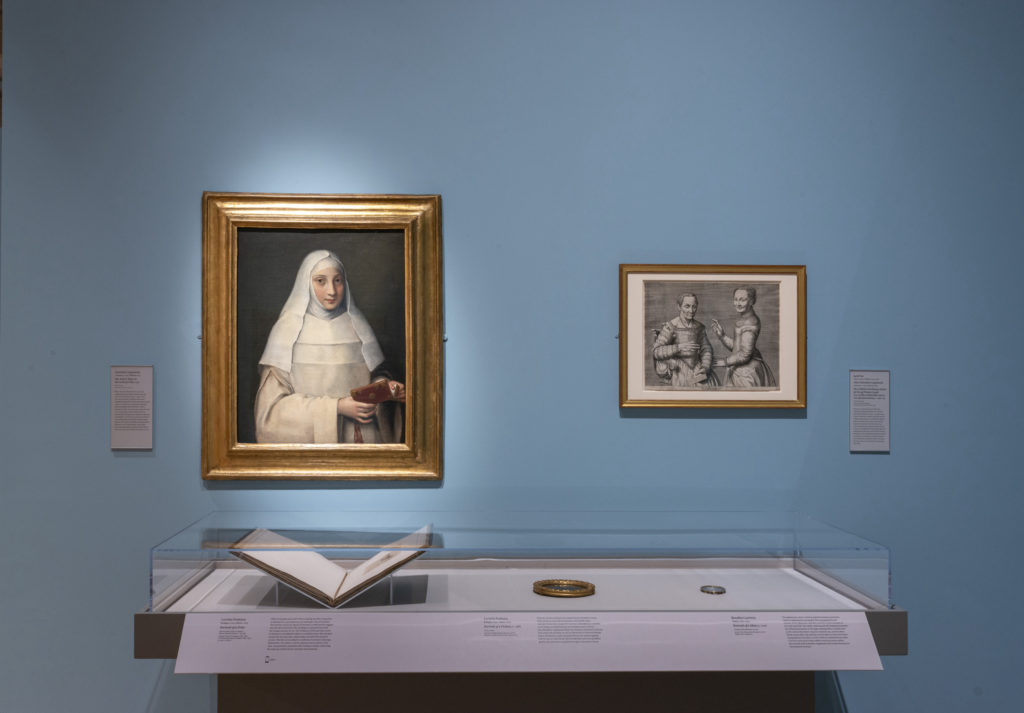
Object juxtapositions in sections of the exhibition include books with pastels and/or gouache, or medals with miniature paintings. Sometimes the variety of mediums serves to showcase differences in talents or training among the assembled artists. But at other times, it highlights the versatility of a single artist. Works on display by Elisabetta Sirani, for example, include paintings on canvas, pen and brown ink drawings, a chalk drawing, and an etching.
Juxtaposing male and female creators
Among the works by men are Pierre Subleyras’ portrait of Maria Felice Tibaldi (Madame Subleyras), an eighteenth-century miniaturist; and Simon Vouet’s portrait of Virginia da Vezzo. While for each woman there is one known extant work—in the case of da Vezzo, Judith, held at Musée d’Arts de Nantes—it wasn’t possible to obtain either painting for display in the exhibition. Obviously, it would be ideal if works by, rather than of, these female artists could be on view. But since that is not possible, I am glad to the organizers found a way to represent Tibaldi and da Vezzo.
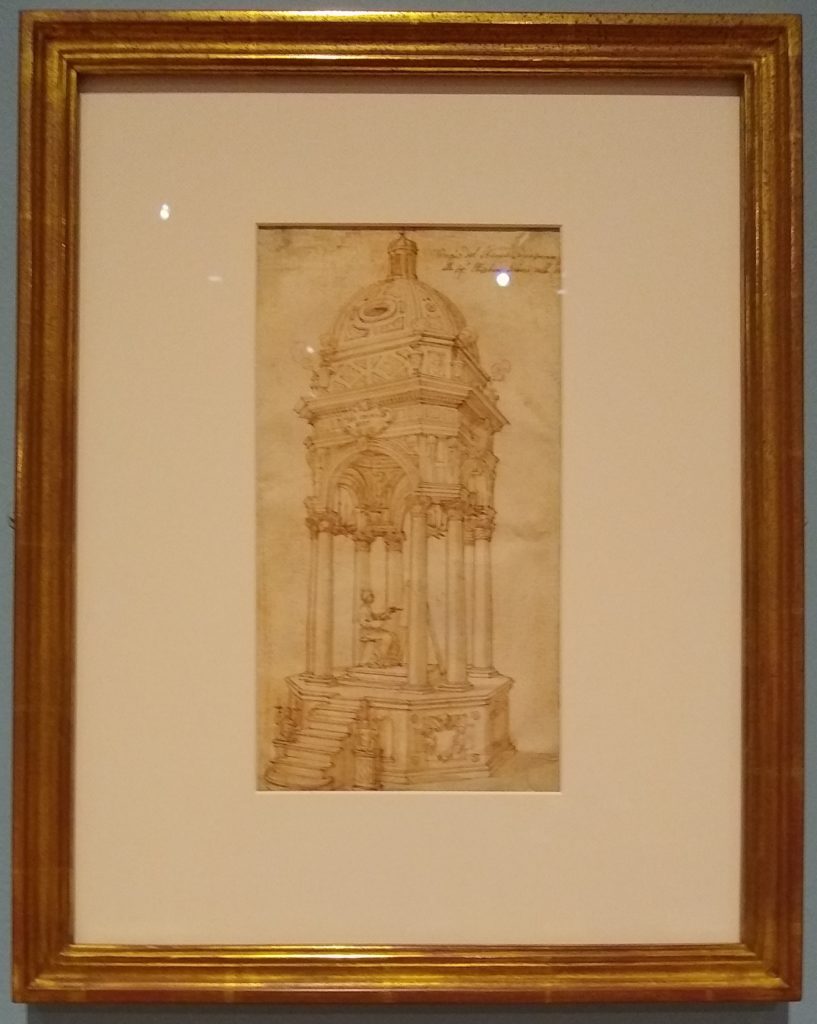
For different reasons, the curators include a drawing by Matteo Borboni. It is the design for the catafalque—a temporary monument displayed at a funeral—for Elisabetta Sirani. Though only 27 years old when she died, Sirani was so well known and beloved that Bologna paid tribute to her with a public funeral. If there are other Italian women artists who were honored in this way, I expect their numbers are vanishingly small; and that visual records of such an occasion are rarer still. We are fortunate that any visual element relating to the Sirani funeral still exists, and I was happy to see it in the show.
Juxtaposing art sources
By “art sources” I mean, who (or, what institution) has loaned the work. The Wadsworth exhibition draws together works from public collections in Canada, the UK, and Italy, as well as all over the US. But it also (it seems to me) presents a higher-than-average percentage—more than a third, according to the exhibition catalog—of works from private collections.

Such works include, but are not limited to, Elisabetta Sirani’s Medici Cupid, one of two extant versions of her Portrait of Anna Maria Ranuzzi as Charity, and Berenice; Ginevra Cantofoli’s Cleopatra; and Giovanna Garzoni’s Hedgehog in a Landscape. All of these are works I have looked at for years on screen, and posted on social media. (The hedgehog, in particular, is always a crowd-pleaser!) But I never expected to see even one of them—never mind all of them!—in person. I am truly grateful to the organizers and lenders for the opportunity to view the original works.
Juxtaposing sizes
The largest work in the show, at 104 1⁄2 × 82 1⁄2” (265.43 × 209.55 cm), is Artemisia Gentileschi’s David and Bathsheba (see above). Lot and His Daughters, by the same artist, is also larger-than-life-sized, with dimensions of 90 3⁄4 × 72” (230.5 × 182.9 cm).

By contrast, Sofonisba Anguissola’s miniature self-portrait of 1556—one of the smaller objects on display, though not the smallest—is only 3-1/4 × 2-1 ⁄2” (8.3 × 6.4 cm). The organizers have, it seems to me, succeed in arranging the layout so that the gargantuan canvases, while displayed to advantage, do not overwhelm the daintier artefacts.

A Slew of “Firsts”
As I mention at the start of this review, By Her Hand is the occasion of many “firsts.” I present at least some of them here, organized by artist but listed in no particular order.
Rosalba Carriera
In something of a coup, the Wadsworth has reunited a complete series of four Carriera pastels, presenting them together for the first time in the United States. The four works were separated in the early 1960s when the series was shared out between two siblings. Scholars believe that prior to this split, the pastels had been together from the time of their creation in the early to mid-1720s.

In 2020, two of the pastels, The Muse Calliope and Allegory of Faith, a Connecticut collector purchased two of the pastels. These two were included in the original plan for By Her Hand, and were on view when the exhibition opened to the public on September 30. (Full disclosure: I saw the two works that were present from the start; but the two late additions I have seen only on screen.) When the remaining two pastels from the series—The Muse Polymnia and The Muse Urania—came on the market in late summer of this year, the same collector in Connecticut acquired them. They were added to the exhibition in October. Their installation in By Her Hand marks the first time the four pastels have been reunited in 60 years.
A visit to the Wadsworth Atheneum is the only opportunity to see this significant set of four pastels. Because the works are too fragile for travel, they will not be included in the Detroit iteration of the show. Read more about the reunion in this ArtDaily article.
Artemisia Gentileschi
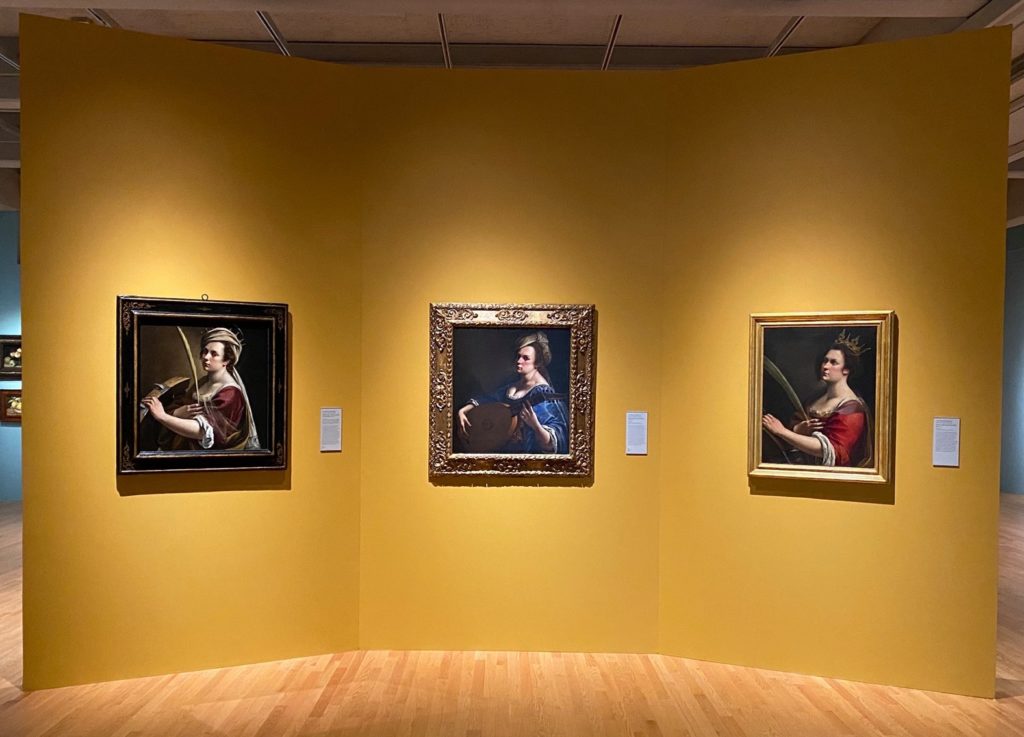
By Her Hand brings together for the first time in the US the three Gentileschi self-portraits shown above. These paintings are: Self-Portrait as Saint Catherine of Alexandria, held at the National Gallery in London; Saint Catherine of Alexandria held at the Uffizi Galleries; and the Wadsworth’s own Self-Portrait as a Lute Player.
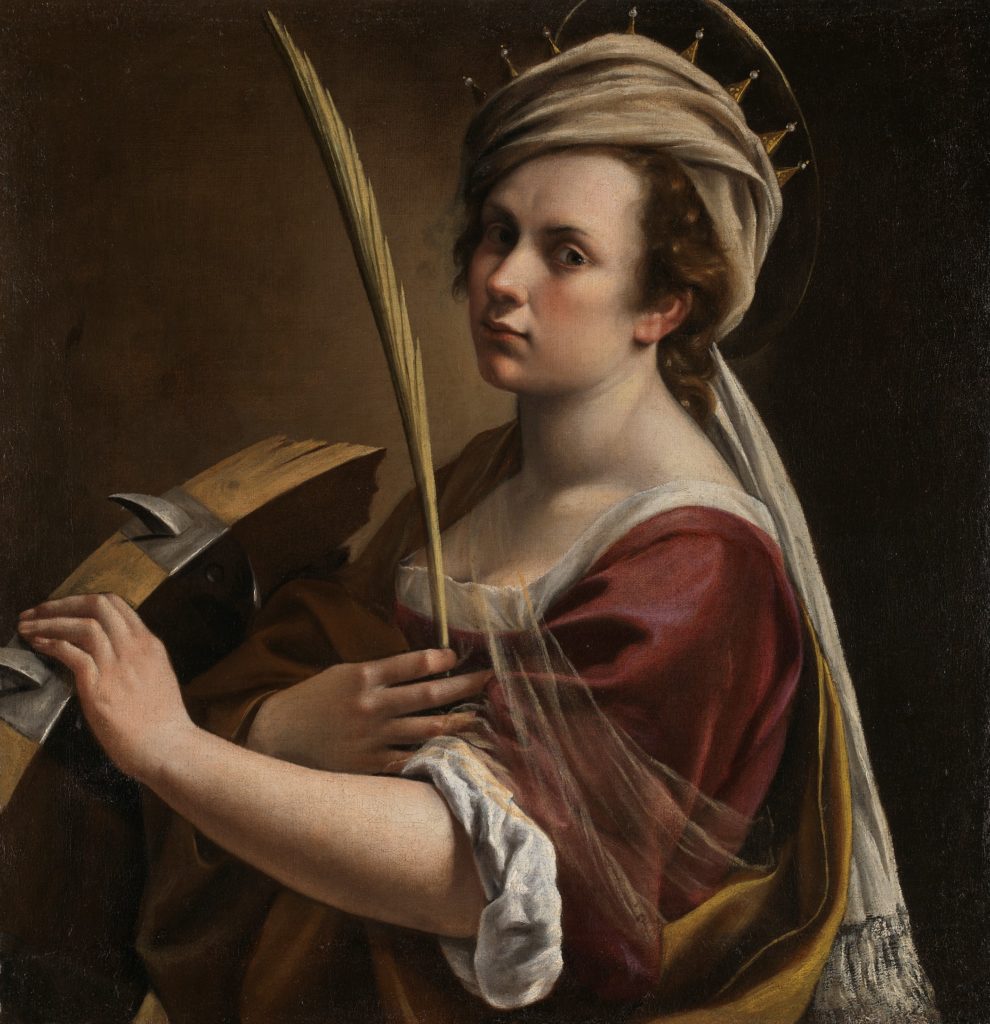
National Gallery, London.
The show marks the first US appearance of the National Gallery painting, which was re-discovered only in 2017. When this work sold in December 2017, the sale price of c. US$2.9 million was the highest price ever realized at auction for this artist. But that price was eclipsed in the 2019 sale of her Lucretia at auction, which according to Hyperallergic and other sources, a dealer purchased for US$5.2 million. The Getty Museum has since acquired this picture.
Another Gentileschi painting making its US exhibition debut in Hartford is the Mary Magdalene in Ecstasy, discussed above.
Sofonisba Anguissola
The Hartford show marks the first display of Portrait of a Spanish Prince, Probably the Infante Don Fernando outside of its home institution, the San Diego Museum of Art. It is thus the first opportunity for viewers to see it in the context of other works by the artist.

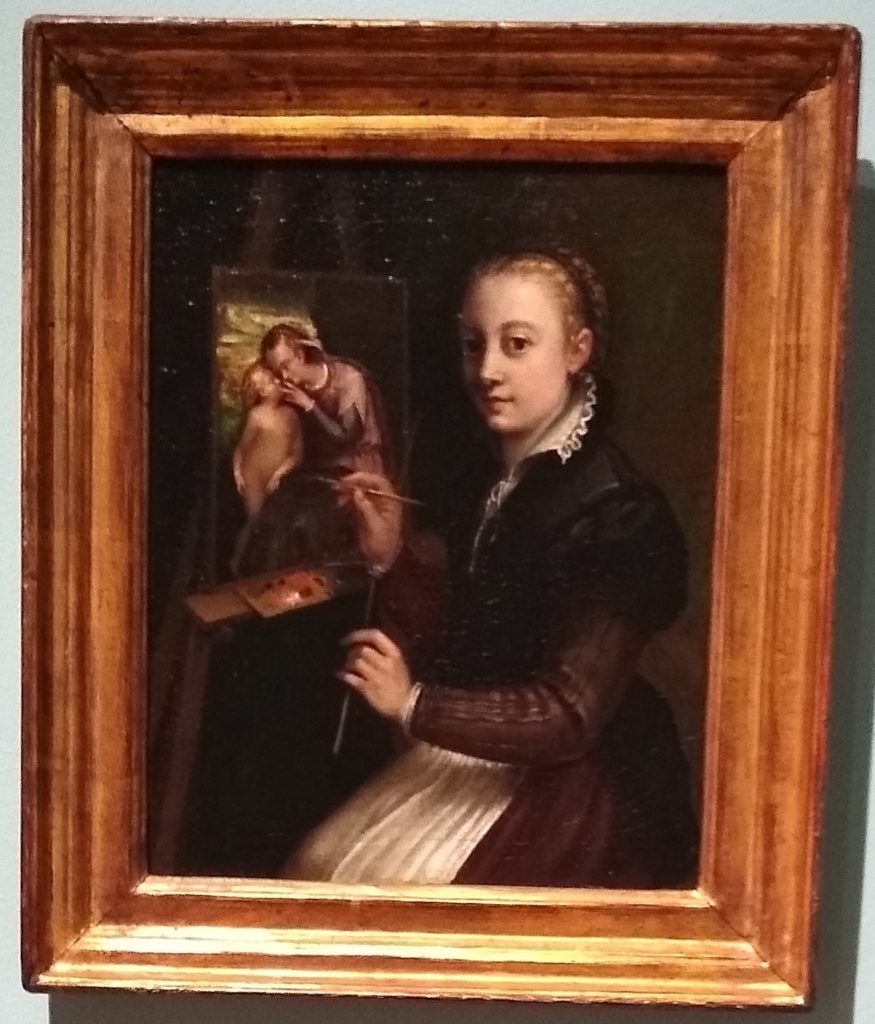
And, two small-scale Anguissola self-portraits, both held by a private collector, make their exhibition debut in By Her Hand.
Elisabetta Sirani
Sirani’s painting Berenice, owned by a private collector, has never before appeared in an exhibition. It is worth mentioning here that some scholars believe figure depicted with scissors in her hand is Delilah, rather than the Egyptian queen Berenice II. Reasonable arguments have been made for either identification. The interesting question to me is: since the artist does record in her diary that she produced a Delilah in 1664, if this work is not the Delilah painting, might it yet turn up?

Also, one of two versions of the artist’s Portrait of Anna Maria Ranuzzi as Charity here makes its first exhibition appearance.
Marietta Robusti
Head of a Man, after the Antique is a drawing by sixteenth-century Venetian artist Marietta Robusti (daughter of Jacopo Robusti, called Tintoretto). A private collector purchased the work at auction earlier this year. Its display in By Her Hand is an exhibition “first” for the drawing. A late add to the line-up, it is not included in the catalog.

Lavinia Fontana
Fontana’s Portrait of a Lady of the Gonzaga or Sanvitale Family, a work held in a private collection, here has its exhibition debut.
Ginevra Cantofoli
Cantofoli’s Cleopatra, also held in a private collection, makes its first exhibition appearance in By Her Hand.

Hartford or Detroit?
If you are not able to see By Her Hand at the Wadsworth—it closes on January 9—perhaps you will be able to visit the exhibition’s Michigan iteration. It will be on at the Detroit Institute of Arts (DIA) from February 6 to May 29. As mentioned above, there are works in the Hartford version that will not make the trip to Detroit. But by the same token, the DIA will display objects that are not on view at the Wadsworth. So, if you are fortunate enough to have the opportunity: see both iterations! I will do my best to arrange an Art Herstory guest review of the DIA By Her Hand.
The broader exhibition context
As I note at the start of this article, By Her Hand is the first exhibition of its kind in the US since 2007. However, in shining a light on early modern women artists, it participates in a wider—and very welcome—trend. Other art museum shows to focus on one or more female painters from the Renaissance through the eighteenth century include:
(Recent) past …
- Fede Galizia, mirabile pittoressa at Castello del Buonconsiglio, Trent (2021; Art Herstory guest review)
- Le Signore dell’Arte. Storie di donne tra ’500 e ’600, at Milan’s Palazzo Reale, (2021; Art Herstory guest review)
- Peintres-Femmes 1780–1830, at Musée du Luxembourg in Paris (2021)
- Artemisia, at London’s National Gallery (2020; Art Herstory guest review)
- “The Greatness of the Universe” in the art of Giovanna Garzoni, at the Uffizi (2020; Art Herstory guest review)
- Angelica Kauffman: Artist, Superwoman, Influencer, at Düsseldorf’s Kunstpalast (2020; Art Herstory guest review)
… present …
- Observations: The Mary Beale Collection, on from now until January 30, 2022, at Moyse’s Hall Museum in Bury St Edmunds
- Artemisia: Vrouw & Macht, on now at Rijksmuseum Twenthe, running through February 23, 2022 (Art Herstory guest review)
- Una rivoluzione silenziosa. Plautilla Bricci pittrice e architettrice, on at Rome’s Galleria Corsini, now through April 19, 2022 (Art Herstory guest review)
- Anna Dorothea Therbusch: A Berlin Woman Artist of the Age of Enlightenment, which opened late last week—in honor of the artist’s 300th birthday this year!—at Berlin’s Gemäldegalerie; it will run through April 10, 2022
… and future
What displays of works by history’s women artists are the world’s art museums planning for 2022 and beyond?! By Her Hand, as stated above, travels in February 2022 to the Detroit Institute of Arts, where it will be on display through May 29. The other shows I know of that have been announced so far are:
- Strong Women in Renaissance Italy at the Museum of Fine Arts, Boston is scheduled to run from September 9, 2023 to January 7, 2024. This show include works by Lavinia Fontana, Sofonisba Anguissola, Diana Scultori, and Isabella Parasole, but is not focused exclusively on women artists. It will also feature works by the hands of women whose names are now lost to us. And it will take in women as subjects, patrons, exempla, and more.
- Lavinia Fontana: Trailblazer, Rule Breaker is set to open in May 2023 at the National Gallery of Ireland in Dublin. Exploring the artist’s extraordinary life through her paintings and drawings, it will be the first monographic exhibition of Fontana’s work in more than two decades. The National Gallery has just completed a major conservation and research project to do with Fontana’s monumental painting The Visit of the Queen of Sheba to King Solomon (1599). Read about the project in curator Aoife Brady’s Art Herstory guest post.
- [Update: for links to many more woman artist exhibitions in 2023, see Museum Exhibitions about Historic Women Artists: 2023.]
There are rumblings of other relevant exhibitions in the planning stages, too. Art Herstory will keep you posted as details of these shows emerge. To stay abreast, sign up for the monthly newsletter—scroll to the very bottom of this page, then complete and submit the form. And/or, follow Art Herstory on Twitter, Facebook, Instagram and LinkedIn.
Erika Gaffney is Founder of Art Herstory. Follow Erika on Twitter, LinkedIn and Facebook.
By Her Hand: Artemisia Gentileschi and Women Artists in Italy, 1500–1800 is on at the Wadsworth Atheneum Museum of Art until January 9, 2022. It will open at the Detroit Institute of Arts on February 6, 2022, where it runs through May 29. A beautifully produced exhibition catalog accompanines the show.
The Wadsworth version* of the show includes works by these women artists: Sofonisba Anguissola; Orsola Maddalena Caccia; Ginevra Cantofoli; Marianne Carlevarijs; Rosalba Carriera; Lavinia Fontana; Fede Galizia; Giovanna Garzoni; Artemisia Gentileschi; Isabella Catanea Parasole; Anna Bacherini Piattoli; Marietta Robusti; Diana Scultori; Elisabetta Sirani; Veronica Stern Telli; Maria Felice Tibaldi; Anna Maria Vaiani; Virginia da Vezzo (also called Virginia Vezzi)
*At least one artist, Sister Caterina de Julianis, will be added for the Detroit version of the show.
More Art Herstory exhibition reviews (in addition to those linked above to past or present museum exhibitions):
Female Artists and their Remarkable Careers: An Appeal to Rethink Art History, by Jenny Körber
Early Modern European Women Artists at the Montreal Museum of Fine Arts, by Erika Gaffney
Rosa Bonheur—Practice Makes Perfect, by Ien G.M. van der Pol
Thérèse Schwartze (1851–1918), by Ien G.M. van der Pol
Reflections on Making Her Mark at the Baltimore Museum of Art, by Erika Gaffney
Sofonisba Anguissola in Holland, an Exhibition Review, by Erika Gaffney with Cara Verona Viglucci
Anna Dorothea Therbusch: A Woman Painting Against Eighteenth-century Odds, by Stephanie Pearson
By Her Hand: Personal Thoughts and Reflections on an Exhibition, by Oliver Tostmann
Artemisia Gentileschi: What Wasn’t in the London Exhibition and Why it Matters, by Jesse Locker
The Many Faces of Suzanne Valadon, by Suzanne Singletary
More Art Herstory posts about Italian women artists:
Plautilla Nelli and the Restoration of her Altarpiece Madonna del Rosario. by Jane Adams
Maddalena Corvina’s Saint Catherine of Alexandria, by Kali Schliewenz
Lavinia Fontana and Elisabetta Sirani at the Smith College Art Museum, by Danielle Carrabino
Lavinia Fontana: Italy’s First Female Professional Artist, by Elizabeth Lev
Drawings by Bolognese Women Artists at Christ Church, Oxford, by Jacqueline Thalmann
Elisabetta Sirani of Bologna (1638–1665), by Adelina Modesti
Suor Orsola Maddalena Caccia (1596–1676), Convent Artist, by Angela Ghirardi
“I feel again the violence of a curious desire”: Rare client testimonies on Rosalba Carriera’s erotic art, by Angela Oberer
Rosalba Carriera at The Frick Collection, by Xavier F. Salomon
Giovanna Garzoni’s Portrait of Zaga Christ (Ṣägga Krǝstos), by Alexandra Letvin
Two of a Kind: Giovanna Garzoni and Artemisia Gentileschi, by Mary D. Garrard
The Protofeminist Insects of Giovanna Garzoni and Maria Sibylla Merian, by Emma Steinkraus
Renaissance Women Painting Themselves, by Katherine McIver
Sister Eufrasia Burlamacchi (Lucca, 1478–1548), by Loretta Vandi
Sister Caterina Vigri (St. Catherine of Bologna) and “Drawing for Devotion,” by Kathleen G. Arthur
The Priceless Legacy of Artemisia Gentileschi: A Curator’s Perspective, by Judith W. Mann

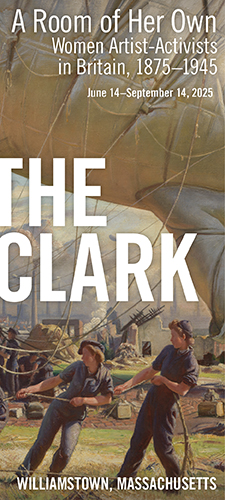

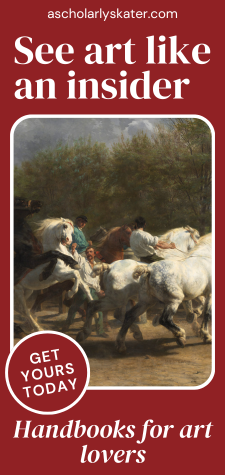

Very thorogh article.